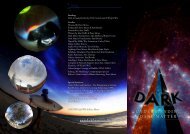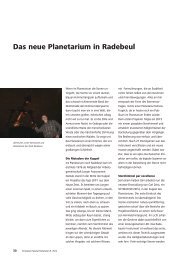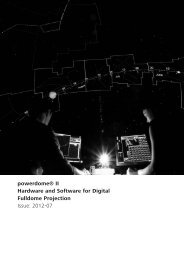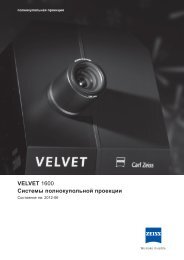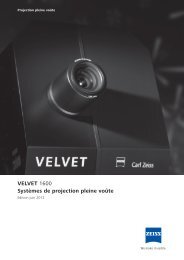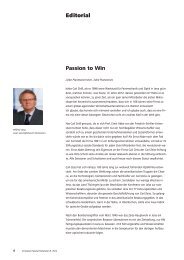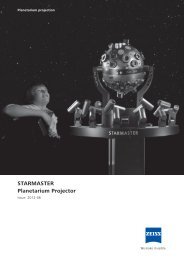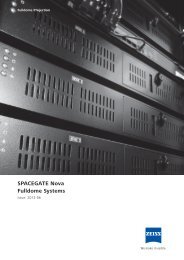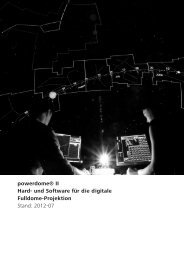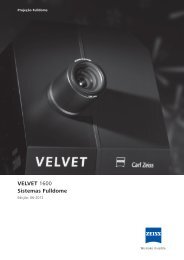Innovation Special Planetariums 9 - Carl Zeiss Planetariums
Innovation Special Planetariums 9 - Carl Zeiss Planetariums
Innovation Special Planetariums 9 - Carl Zeiss Planetariums
You also want an ePaper? Increase the reach of your titles
YUMPU automatically turns print PDFs into web optimized ePapers that Google loves.
ally live in a paradise on Earth. And they<br />
should make sure it stays this way.<br />
At the end of the presentation there is<br />
even a little cherry on the cake – a flight<br />
from the solar system through the stars<br />
and out of our home galaxy. The previously<br />
stationary stars move in a thick<br />
swarm, ever faster, until the Milky Way<br />
becomes recognizable in its wonderful<br />
spiraling shape. Countless little dots<br />
around the sky form the neighboring<br />
galaxies. The children get a short<br />
glimpse of infinity, even if only on a<br />
virtual basis. The data, though, are real.<br />
The “Uniview” program enables the two<br />
dimensions of the “flat” planetarium to<br />
add a third dimension, to give depth<br />
and perspective to the space and to better<br />
explain relationships in this way.<br />
Finally, and to the children’s great regret,<br />
everyone comes back to Earth.<br />
Many will remember this class for a<br />
long, long time to come.<br />
06:00 p.m., the first evening perfor-<br />
mance. The program promises “Voices<br />
in the Dark”. No astronomy this time,<br />
but a voyage into the realm of fantasy,<br />
through a paradise landscape towards<br />
a mysterious villa and then into it…<br />
The viewers dive into chessboards and<br />
land in a black and white, Cubistic<br />
landscape – and a night sky suddenly<br />
emerges from a plunging shaft. Change<br />
of scenery: A sunken cathedral turns up<br />
under water. Indeed, with this technique<br />
the visitors literally “plunge”. The term<br />
“immersive medium”, which means<br />
exactly that, suddenly becomes self-explanatory.<br />
The dome projection enables<br />
a three-dimensional experience without<br />
any need for cumbersome glasses.<br />
The strong contrast of the VELVET<br />
projectors also makes it possible, as in<br />
the next program, which is the “Heavenly<br />
Stroll”, to continually change from<br />
the conventional night sky to fulldome<br />
sequences without the basic brightness<br />
of the beamers, which are then<br />
not required, disturbing the view of the<br />
stars. This is another live presentation,<br />
and the presenter is now explaining that<br />
the constellations that are so familiar to<br />
us really bear no relation to the actual<br />
stars, but that they are arbitrary patterns<br />
instead. To clarify things, the public<br />
suddenly flies towards the Big Dipper,<br />
sketched out by means of stick figures<br />
that connect the stars, and then around<br />
it. The shape of the image becomes<br />
distorted and unrecognizable. The stars<br />
constituting the Big Dipper are in actual<br />
fact positioned at different distances<br />
from Earth. The stars that are close by<br />
and those that are further away whirl<br />
around the viewers as if they were sitting<br />
in a spaceship. This is also a very<br />
enjoyable feeling for many people.<br />
By means of examples, fulldome explains<br />
facts clearly, but the system can<br />
also generate emotions that amaze both<br />
children and adults and make them<br />
dream – and this is ultimately at least as<br />
important as the pure communication of<br />
knowledge. It is certainly possible to go<br />
through daily life without any knowledge<br />
of astronomy. The ultimate task<br />
planetaria can and should accomplish is<br />
to provide people with a perspective of<br />
their world and to broaden their inner<br />
and outer horizons, and the fulldome<br />
“space experience” can certainly help in<br />
this process.<br />
Fotos: M. Staesche.<br />
“Credentials”<br />
Planetarium of the<br />
Wilhelm Foerster Observatory<br />
Munsterdamm 90<br />
12169 Berlin, Germany<br />
ZEISS powerdome®VELVET<br />
ZEISS Modell VB<br />
UNIVIEW<br />
Opening: 1965<br />
Reopening: 2010<br />
Dome diameter: 20 m<br />
Seats: 291<br />
www.planetarium-berlin.de<br />
<strong>Innovation</strong> <strong>Special</strong> <strong>Planetariums</strong> 9, 2012<br />
35




